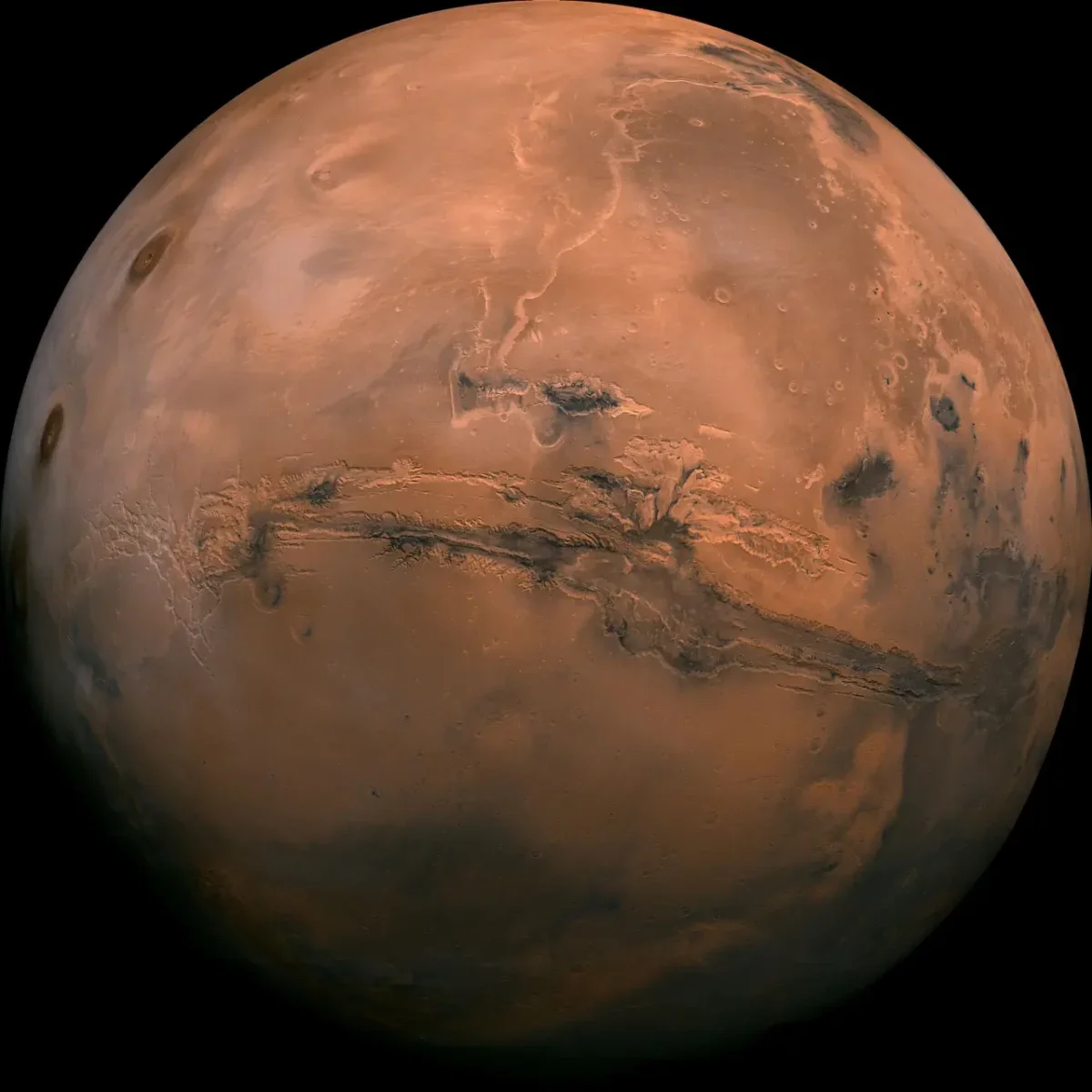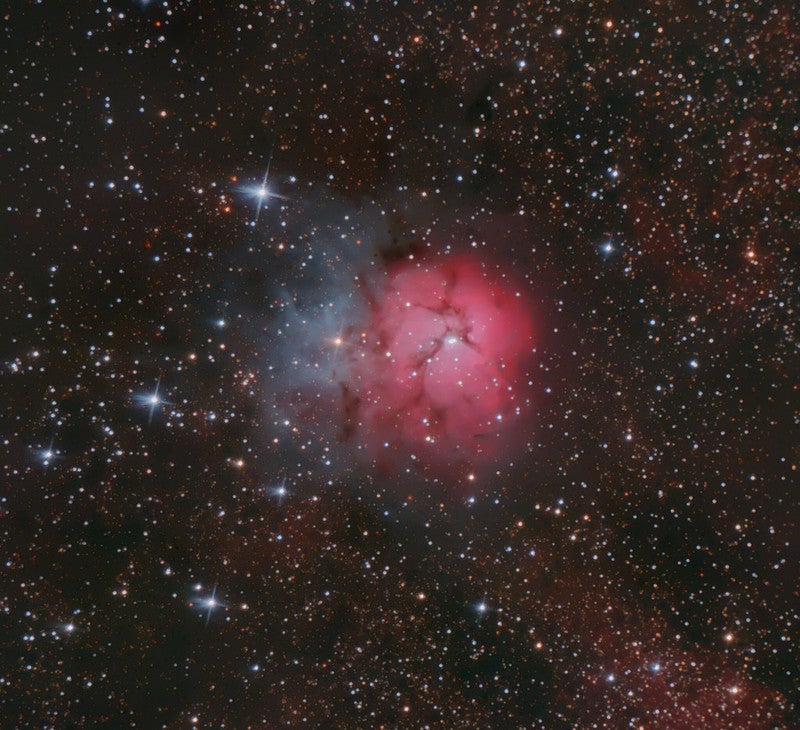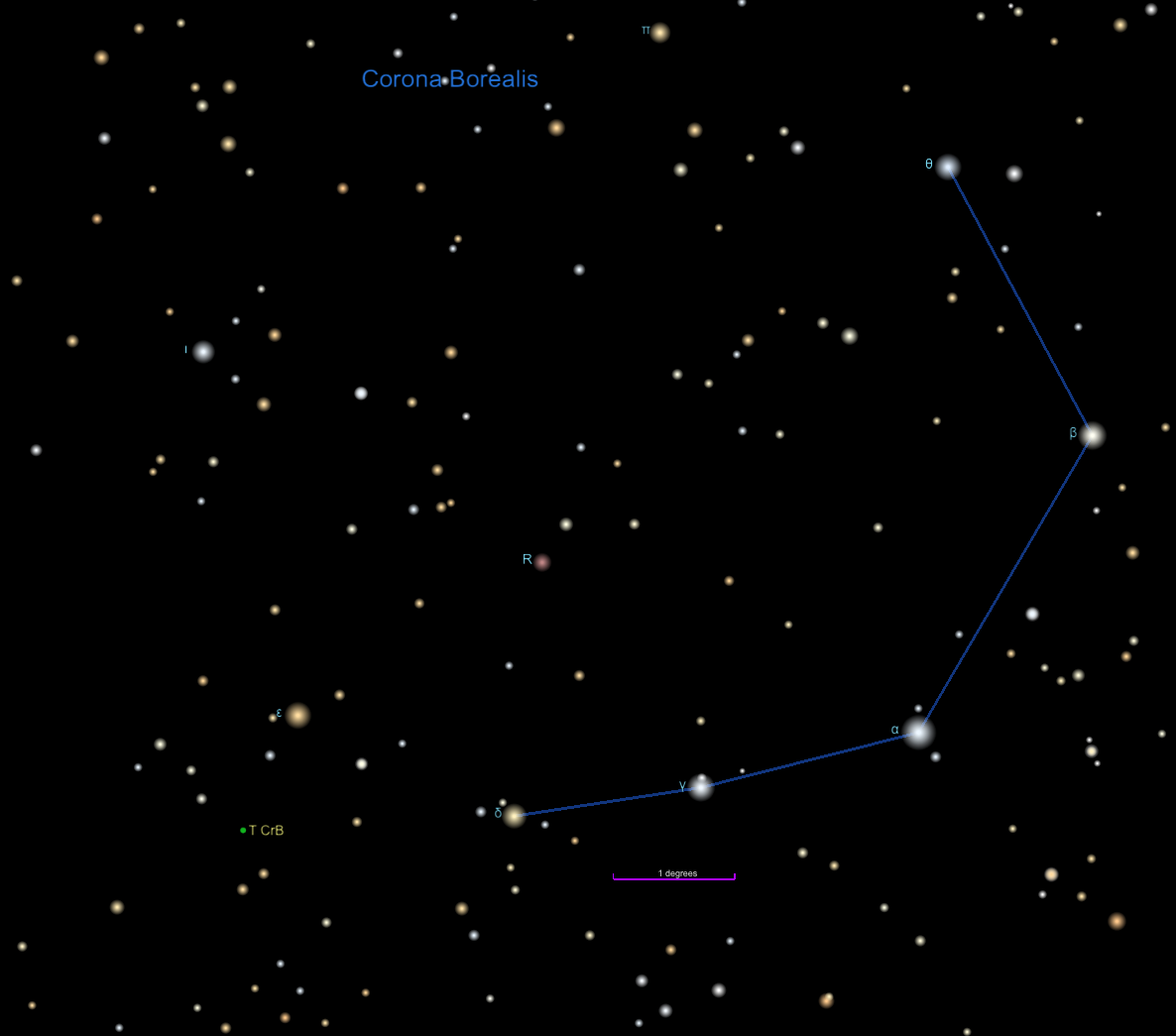
Friday, November 1
New Moon occurs this morning at 8:47 A.M. EDT.
The planet Mercury is now becoming visible, low in the evening sky. If you have a clear view southwest, you may catch the planet some 30 minutes after sunset, hanging just 2° above the horizon. Although bright at magnitude –0.3, it may be difficult to spot in the glow of twilight and the muddy air near the horizon. If you can’t see it by eye, try using binoculars or a telescope, which should bring it into view. Mercury is now 5” across and shows off a gibbous phase some 85 percent lit.
Higher in the sky, brighter and easier to locate, is Venus. This world is some 19.5° to Mercury’s upper left and about 12° high half an hour after sunset. Venus glows at magnitude –4 in southern Ophiuchus — some 30 times brighter than Mercury. The larger, closer planet appears 14” wide in a telescope, but has a slightly smaller phase, some 77 percent lit. Venus now remains visible for roughly two hours after sunset, glowing brightly as the stars around it slowly pop into view.
Sunrise: 7:30 A.M.
Sunset: 5:57 P.M.
Moonrise: 7:41 A.M.
Moonset: 5:47 P.M.
Moon Phase: New
*Times for sunrise, sunset, moonrise, and moonset are given in local time from 40° N 90° W. The Moon’s illumination is given at 12 P.M. local time from the same location.
Saturday, November 2
Rising around 8 P.M. local daylight time this evening, Jupiter is a bright point of light between the horns of Taurus the Bull. Zoom in on the planet with a telescope, and you’ll also catch sight of its four Galilean moons. Callisto stands on its own far to the west, with Europa alone far to the east. Closer to the planet, also to the east, Io and Ganymede jockey for position early in the evening as Io moves from west to east and Ganymede from east to west. Around 10:20 P.M. EDT, Io passes due north of Ganymede; after that time, Ganymede is closer to Jupiter, with Io farther to the east.
Keep watching and you’ll see Ganymede’s huge shadow appear on at Jupiter’s southeastern limb, starting around 10:39 P.M. EDT. The shadow continues across the southern polar regions for about two hours, starting to slip away from the southwestern limb at 12:44 A.M. EDT (on the 3rd for those in the Eastern time zone only). Ganymede itself follows in a transit starting around 1 A.M. CDT — just as clocks have fallen back from 2 A.M. EDT to 1 A.M. EST for those in the Eastern time zone, as daylight saving time comes to an end.
While you’ve got your telescope out, slide your gaze east along the ecliptic to Cancer, where magnitude 0.1 Mars stands just 7’ from much fainter magnitude 5.3 Mu (μ) Cancri in the western portion of the constellation.
Sunrise: 7:31 A.M.
Sunset: 5:56 P.M.
Moonrise: 8:45 A.M.
Moonset: 6:18 P.M.
Moon Phase: Waxing crescent (1%)
Sunday, November 3
For those in locations that observe it, daylight saving time ends this morning at 2 A.M. local time. So, at 2 A.M. in your location, clocks will “fall back” one hour earlier, to 1 A.M.
The Moon passes 2° south of Mercury at 3 A.M. EST, though neither is visible at that time. However, you can catch our satellite briefly in the evening sky, as the Moon passes 0.08° south of Antares at 8 P.M. EST. Some 30 minutes after sunset, a thin crescent Moon stands to the lower right of Antares in the southwest as dusk falls. Our satellite is just 6 percent lit, as sunrise begins creeping over its eastern limb. Antares, at magnitude 1.1, should be one of the first stars in this region of the sky to appear; alternatively, search the region just above the Moon’s shadowed northwestern limb with binoculars or a telescope to find the ruddy star.
Also see if you can spot Mercury, again still roughly 2° high half an hour after sunset and to the lower right of the Moon, as well as Venus to the group’s far upper left.
If you prefer observing in a darker sky, the bright moon Titan stands near its parent planet, Saturn, this evening. Try looking with a telescope around 7:30 P.M. local time, when Saturn is high in the south — it’s the brightest point of light in this region of the sky.
And over at Jupiter, Europa and its shadow transit later in the evening; the shadow’s journey across the cloud tops begins around 10:30 P.M. EST, with Europa following around 12:10 A.M. EST (on the 4th for the Eastern time zone only).
Sunrise: 6:32 A.M.
Sunset: 4:55 P.M.
Moonrise: 8:50 A.M.
Moonset: 5:54 P.M.
Moon Phase: Waxing crescent (5%)

Monday, November 4
The Moon has moved from Scorpius into Ophiuchus, and passes 3° south of Venus at 7 P.M. EST. The pair are visible for nearly two hours after sunset, with some 11 percent of the Moon’s eastern hemisphere now lit by the Sun.
To their upper left in the sky as it grows dark is the Teapot asterism of Sagittarius, consisting of eight stars that form a pattern shaped like a teapot with its spout to the right and handle to the left on the sky. Above the spout, some 8° north-northwest of magnitude 2.7 Delta (δ) Sagittarii, is M20, also known as the Trifid Nebula. Containing both a reflection and emission nebula, this object is cut through with dark dust lanes and shows up well in astrophotos. Despite a magnitude of 6.3, however, it can be difficult to see visually, as it spans nearly the same size on the sky as the Full Moon, which spreads its light out significantly. If you’ve got a narrowband filter, try dropping that into your scope to see whether it better brings out the nebula’s diffuse glow when visually searching for this famous deep-sky gem.
Sunrise: 6:33 A.M.
Sunset: 4:53 P.M.
Moonrise: 9:53 A.M.
Moonset: 6:38 P.M.
Moon Phase: Waxing crescent (10%)
Tuesday, November 5
Mars now appears 9” wide on the sky — not large, but big enough to start making out some of its features with a good scope, good seeing, and astrophotography techniques. Plus, now is a great time to begin practicing high-speed video capture on the Red Planet, as it will only continue to improve as it approaches opposition in a few months.
Around 5 A.M. local time in the mid-U.S., Mars is some 70° high in western Cancer the Crab. The famous feature Valles Marineris should be visible, centrally located on the martian disk around this time. (Note that those on the East Coast should look an hour earlier, and those west of the mid-U.S. an hour or two later for the same view.) Stretching over 2,000 miles (3,000 kilometers) long and 370 miles (600 km) wide, this huge canyon lies northwest of the dark feature Solis Lacus. which may also be discernible. If you continue observing, you’ll see the brighter Tharsis region rotate onto the disk, as well as the huge volcano Olympus Mons.
Sunrise: 6:34 A.M.
Sunset: 4:52 P.M.
Moonrise: 10:52 A.M.
Moonset: 7:32 P.M.
Moon Phase: Waxing crescent (16%)
Wednesday, November 6
A few hours after sunset, Cetus the Whale reaches 30° in altitude above the southeastern horizon. Within the center of this large constellation is Mira (Omicron [ο] Ceti), a variable star that, according to the late stellar expert Jim Kaler, is the only star in the sky with a proper name that is at times too faint to see with the naked eye.
That’s because Mira is a variable star whose magnitude alternates between roughly 3rd and 10th magnitude over the course of about 11 months. The star is currently fading, now visible only with binoculars or a telescope around 9th magnitude. To find it, look about 13° to the right (southwest) of 2nd-magnitude Menkar (Alpha [α] Ceti) as the constellation is rising this evening. For a closer steppingstone, Mira is 6° southwest of 4th-magnitude Delta Ceti.
Mira is in the late stages of its life, and astronomers believe it will someday produce a planetary nebula, after which it will leave behind only its core as a white dwarf.
Sunrise: 6:35 A.M.
Sunset: 4:51 P.M.
Moonrise: 11:44 A.M.
Moonset: 8:35 P.M.
Moon Phase: Waxing crescent (24%)
Thursday, November 7
The 10th-magnitude moon Tethys crosses the southern hemisphere of Saturn in a transit that starts just before 10 P.M. EST this evening and ends just after 12:30 A.M. EST on the East Coast (early on the 8th for those in the Eastern time zone).
Saturn, at magnitude 0.8, stands out easily amid the stars of Aquarius in the southwest. It’s setting for most observers, though remains above the horizon from most locations throughout the event (it may dip below the horizon for those farthest east). Because Tethys is so small, it may be difficult to track visually. The same high-speed video capture techniques used to view martian features will help here, allowing astrophotographers to pick up the moon’s transit.
As Tethys transits, its shadow is projected onto the rings themselves, appearing around 10:25 P.M. EDT and disappearing roughly three hours later. This may be extremely difficult or impossible to pick up, however, even with advanced techniques. The rings are tilted toward us at an angle of just 5°; they stretch some 41” from end to end, but only about 3” along the narrower axis. Nonetheless, they are a stunning feature that can be enjoyed through binoculars or any telescope, even if you can’t spot Tethys’ transit. Look also for brighter, 8th-magnitude Titan, now standing far to Saturn’s west.
Sunrise: 6:36 A.M.
Sunset: 4:50 P.M.
Moonrise: 12:27 P.M.
Moonset: 9:44 P.M.
Moon Phase: Waxing crescent (34%)

Friday, November 8
Venus now leaves Ophiuchus for Sagittarius, crossing into the Archer late this evening and standing at the border of the two constellations as it sets in the southwest after sunset.
Over in the west after sunset, hanging below the Keystone of Hercules, is the curved constellation Corona Borealis. Though small and somewhat lesser-known, Corona Borealis is also relatively bright, with nearly two dozen of its stars cracking magnitude 5.5. Its alpha star, magnitude 2.2 Alphecca, is among the sky’s 200 brightest stars. It is located near the constellation’s southern border and marks the rough midpoint of the curved crown. To its north are Beta (β) and Theta (θ) CrB, while to its east are Gamma (γ), Delta, and Epsilon (ε) CrB.
Just 1° southeast of Epsilon is T CrB, a famous recurrent nova that last exploded in brightness in 1946. Astronomers believe another explosion and brightening event are imminent, which should kick the normally 10th-magnitude star up to naked-eye visibility, around 2nd magnitude. Observers around the world are waiting with bated breath for a “new” star to briefly appear in the Northern Crown. When it does, it will be short-lived, remaining visible to the naked eye for perhaps a few days before fading again.
Sunrise: 6:38 A.M.
Sunset: 4:49 P.M.
Moonrise: 1:04 P.M.
Moonset: 10:56 P.M.
Moon Phase: Waxing crescent (44%)

Sky This Week is brought to you in part by Celestron.









